Kentucky is a beautiful state filled with lush green forests, rolling hills, and abundant wildlife. The Bluegrass State is home to many native plants essential to its ecology and biodiversity. These plants have adapted to Kentucky’s climate, soil, and other environmental conditions over thousands of years, making them uniquely suited for the region.
Kentucky is home to not only bluegrass but a variety of other native plants. Discover wildflowers, trees, and other native plants that play a vital role in Kentucky’s landscape in this article.
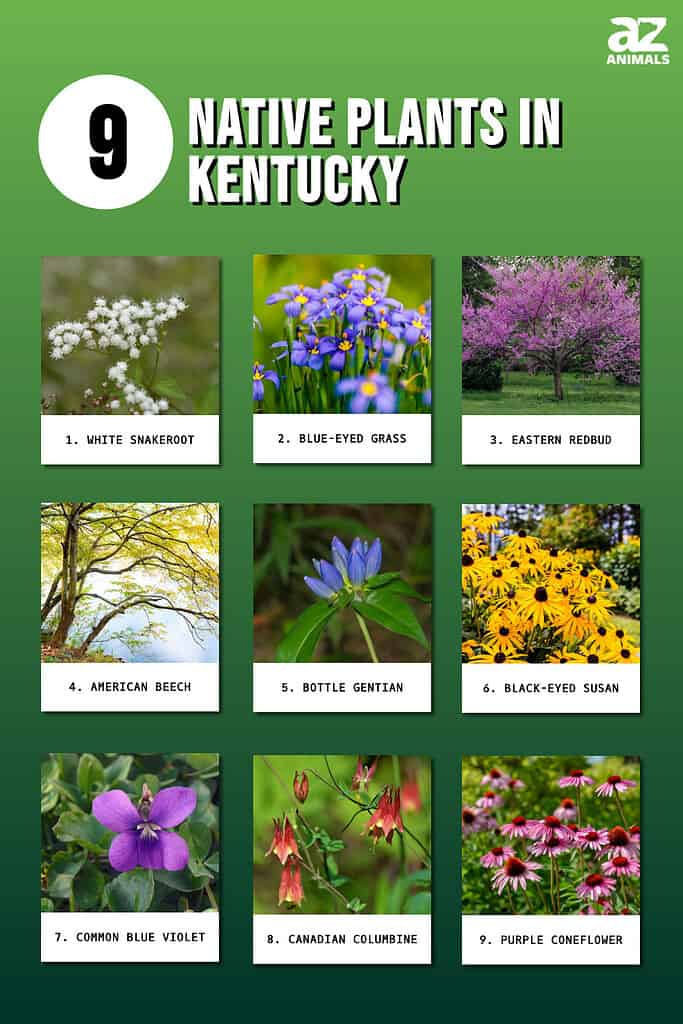
1. White Snakeroot (Ageratina altissima)

The white snakeroot gets its name from the fact that it was traditionally used by Native Americans to treat snake bites.
©Nahhana/Shutterstock.com
White snakeroot (Ageratina altissima) is a small, white-flowering perennial herb native to Kentucky, among other states. It can grow up to four to six feet in height and has oblong leaves, usually dark green on top and lighter underneath.
The plant produces small clusters of daisy-like white flowers in the late summer and fall. White snakeroot requires moist soils and partial sunlight to thrive and prefers to grow in areas of low soil fertility.
This durable and adaptable plant is an excellent addition to any Kentucky garden, as it offers both beauty and resilience.
White snakeroot has a long history of being used for medicinal purposes. However, unknown to those early settlers, the white snakeroot produces a toxin called tremetol, which is poisonous to mammals – including humans – when ingested. Prior to this knowledge, this plant killed thousands of people through tremetol vomiting, also called milk sickness.
So, though the white snakeroot may be a beautiful addition to your garden, do take care and ensure your pets and young children don’t accidentally ingest it!
2. Blue-Eyed Grass (Sisyrinchium angustifolium)
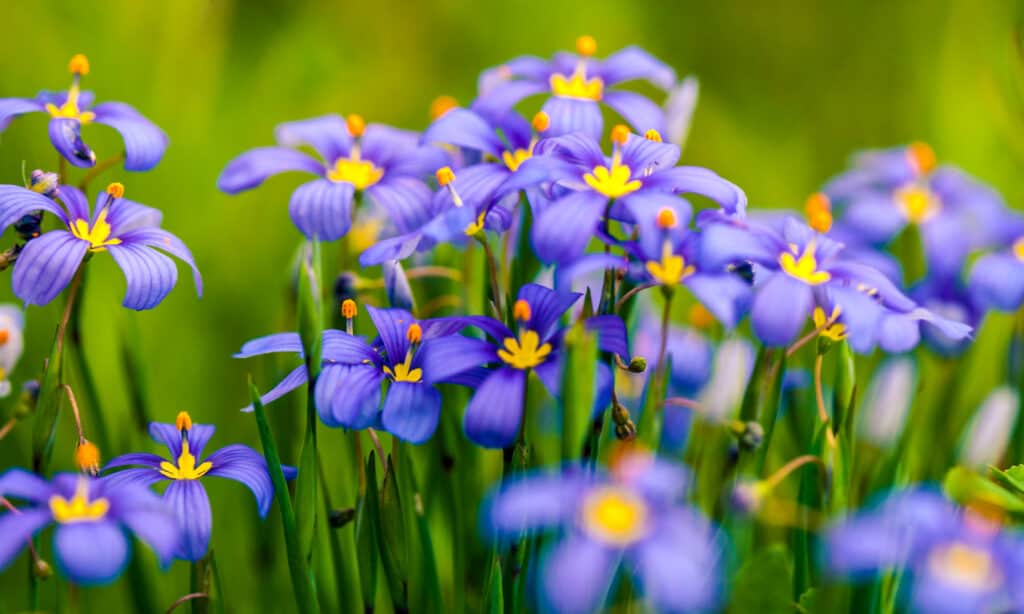
Blue-eyed grass prefers full sun but tolerates light shade and moist soil.
©Moab Republic/Shutterstock.com
The blue-eyed grass (Sisyrinchium angustifolium) is a perennial wildflower native to the prairies and open woodlands of Kentucky. This stunning plant features nodding blue flowers with a white-yellow center that grows to be half an inch across. Its grass-like leaves are narrow and bright green. The plants grow to a height of 1 to 2 feet, making them ideal for borders and rock gardens.
Blue-eyed grass prefers full sun but tolerates light shade and moist soil. These flowers bloom from April to June and are a major attraction for butterflies and hummingbirds. If you want to bring some life to your garden, blue-eyed grass is a great choice.
You can use this plant for ornamental planting and soil erosion control. Its roots form a mat that helps to protect the soil from washing away in heavy rains. The plant can also help to improve the soil quality in your garden. Blue-Eyed grass is a beautiful and valuable addition to any flower bed or wildflower meadow.
3. Eastern Redbud (Cercis canadensis)
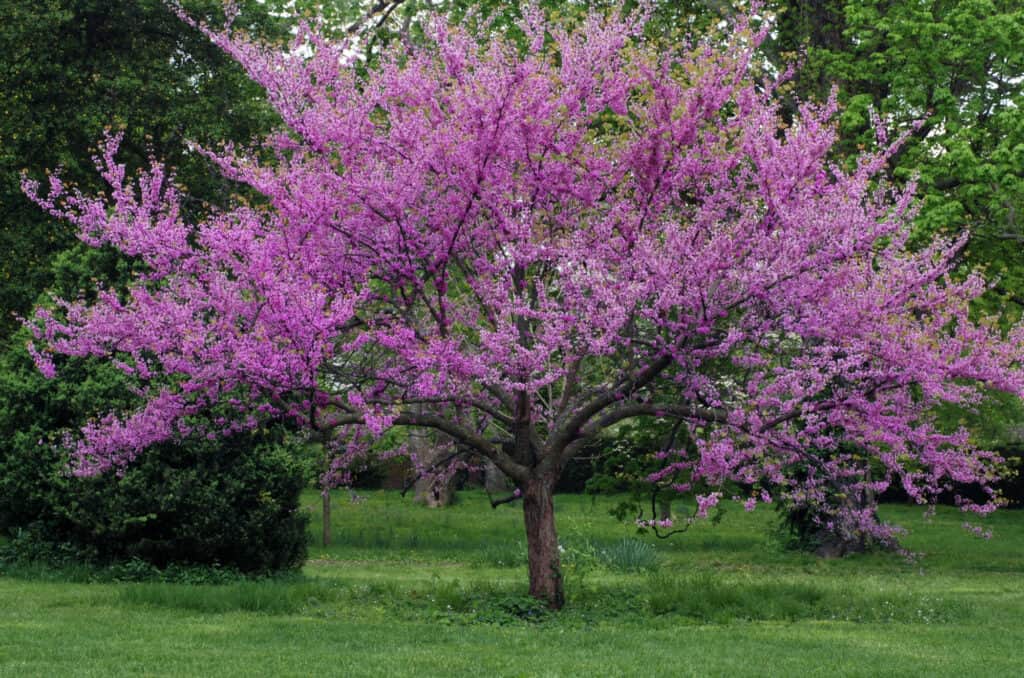
The Eastern redbud trees reach up to 30 feet high.
©Marie C Fields/Shutterstock.com
Eastern redbuds (Cercis canadensis) are small trees native to Kentucky’s woodlands and thickets. They grow up to 20 to 30 feet tall with a rounded crown and attract butterflies, bees, and other insects in the spring when their showy, pea-like pink or purplish flowers bloom.
This deciduous tree likes shady areas and prefers well-drained soil. They are known for their vivid fall colors, with yellow, orange, and deep red leaves, making them a popular choice for landscaping. Eastern redbuds are also drought-tolerant and require little maintenance, so they are a great tree for novice gardeners.
These small, beautiful trees are often used for framing or as specimen plants. They also make an excellent background for flower beds and borders. While the flowers are short-lived, the tree’s unique bark texture and structure make it an exciting addition to any landscape.
Its branches were used for basket weaving by Native Americans, and the flowers are edible. The seeds are also edible and can be roasted for a unique flavor. In some parts of Appalachia, the eastern redbud is used to spice and flavor wild game, such as venison.
The eastern redbud is an iconic Kentucky native plant as it’s easy to care for and provides a beautiful backdrop for gardens and nature trails. Plus, who can resist its stunning pink blooms?
4. American Beech (Fagus grandifolia)

The flowers of the American beech appear as small brown buds in April and May.
©Gerry Bishop/Shutterstock.com
The American beech (Fagus grandifolia) is a slow-growing, deciduous tree found in Kentucky’s woods. It has light silvery-gray bark, and its leaves are elliptical with a toothed or serrated margin. It is highly resistant to cold temperatures, making it ideal for Kentucky’s climate.
The American beech typically has a beautiful display of yellow leaves in the fall, and its flowers appear as small brown buds in April and May. This tree is common in moist hardwood forests and can be found in many parks and older parts of town.
The American beech produces nut-like fruits enjoyed by numerous bird species, and its wood is used in furniture, flooring, and handicrafts. Its bark is unique in that it doesn’t grow rough with age and instead retains its smooth texture. This means that if anything is carved onto the tree, the carving will likely remain indefinitely. A symbol of strength and endurance, the American Beech is a beautiful addition to Kentucky’s native plants.
5. Bottle Gentian (Gentiana andrewsii)
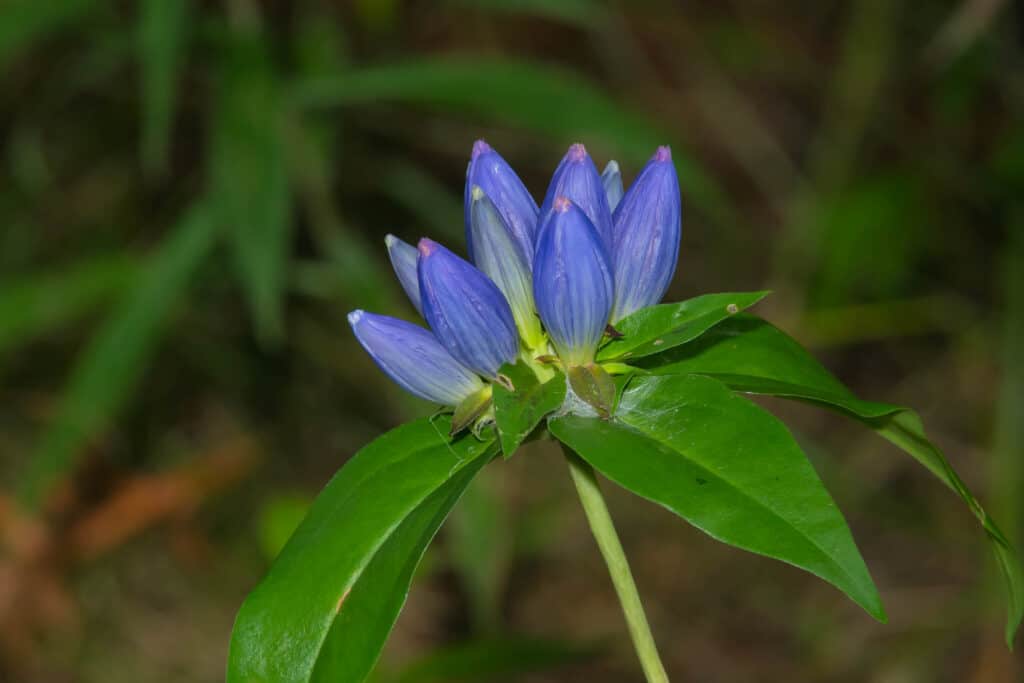
Bottle gentian flowers bloom from late summer into early fall.
©iStock.com/PaulReevesPhotography
The beautiful bottle gentian, also called Gentiana andrewsii, blooms in the late summer or early fall and is easily recognized by its bright blue petals clustered at the top of the plant. As hinted by this name, the flowers have a bottle-like shape.
This gorgeous plant can grow up to 1 to 2 feet tall in the right conditions. Bottle gentian prefers moist, sandy, or gravelly soils and full sun to light shade. It’s found in the cooler northern parts of Kentucky and can be seen along streambanks, rocky woods, meadows, and even roadsides.
This plant is a great addition to any flower bed, as it’s known for its long bloom time and bright flowers. It makes for an excellent cut flower, as it can last up to two weeks in a vase. So if you’re looking for something that’ll brighten your yard and keep its color all season long, make sure to plant a bottle gentian.
This plant is often used medicinally for digestive issues, as well as in teas and tinctures. Americans also used this plant in folk medicine for its anti-inflammatory, astringent, and antiseptic properties. Additionally, it’s a great food source for birds, caterpillars, and other pollinators.
Please note: A-Z Animals does not recommend plants or herbs for medicinal or health use. We present the following information for academic and historical purposes only.
6. Black-Eyed Susan (Rudbeckia hirta)
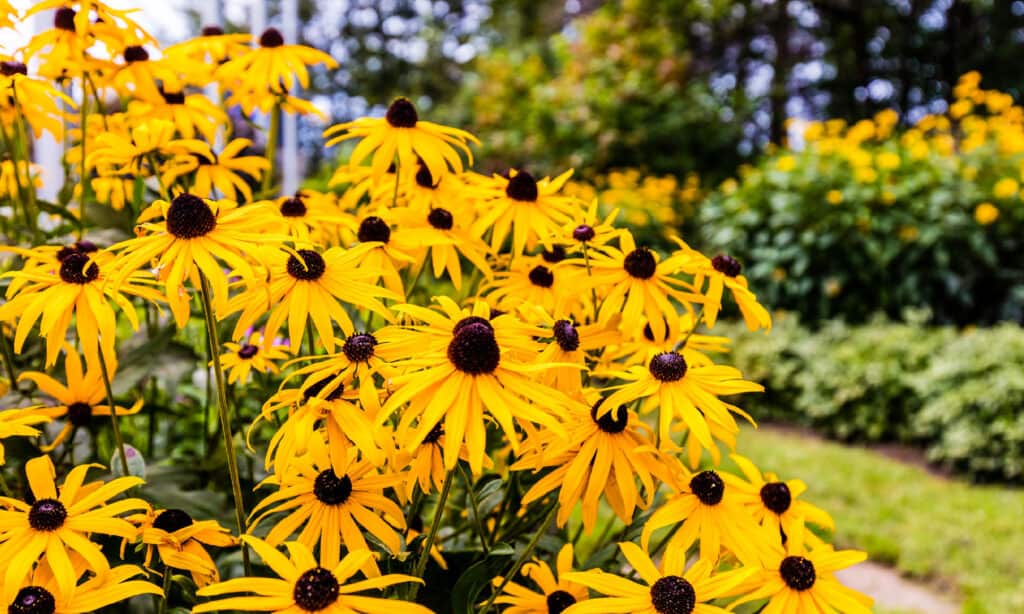
The bright yellow petals of the black-eyed Susan have become a symbol of summer in Kentucky.
©iStock.com/Dopeyden
The black-eyed Susan is a cheerful, annual wildflower that is native to many parts of the USA, including Kentucky. It has an iconic yellow-petaled flower with a black center and grows to heights of 1 to 4 feet. The iconic black-eyed Susan generally has anywhere between 8 to 20 petals.
This plant prefers full sun and does not need much in the way of soil or water to thrive, so it’s a relatively low-maintenance plant – great for beginners. It blooms from mid-summer through early fall, and pollinators love its flowers. Black-eyed Susans can be planted from seed, but it’s important to note that they are short-lived and only last a year or two. But despite that, it is a gorgeous plant that is popular with landscapers for a reason!
The bright yellow petals of the black-eyed Susan have become a symbol of summer in Kentucky, popping up in meadows and wildflower bouquets alike! Plant a few of these happy flowers in your garden to bring some sunshine into your life.
7. Common Blue Violet (Viola sororia)
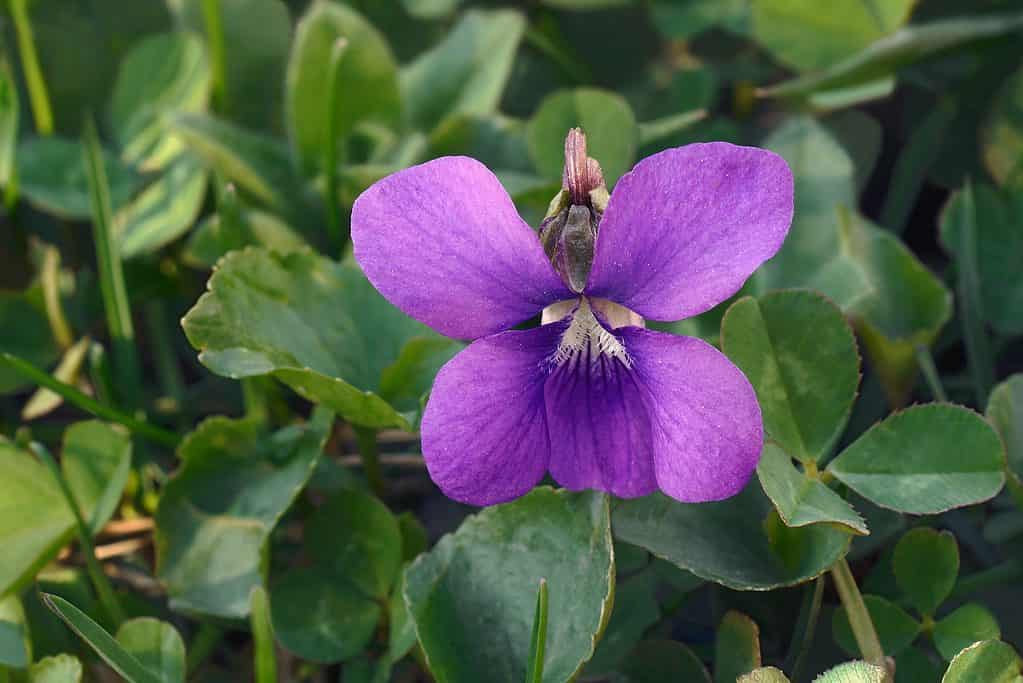
With its hardy and adaptable nature, the common blue violet is an easy addition to any native plant garden.
©Nikolay Kurzenko/Shutterstock.com
The common blue violet is another wildflower in Kentucky that’s sure to turn heads. With its showy, bright-purple petals and yellow eye, it offers a unique pop of color to any native plant garden. This particular species of wildflower will grow in both full sun and part shade, making it easy to fit into any garden. It blooms from March to May, so you’ll surely get plenty of enjoyment out of this beauty.
The common blue violet grows up to 6 to 10 inches tall and wide and is a low-maintenance plant. You won’t need to multiply yourself, as it easily reseeds itself in ideal conditions. This versatile violet can be found in various areas, including in coastal gardens, beds, rock gardens, woodland gardens, and more!
The common blue violet is also a larval host for the Fritillary butterfly, so it’s an integral part of their ecosystem. With its hardy and adaptable nature, this wildflower is an easy addition to any native plant garden.
8. Canadian Columbine (Aquilegia canadensis)
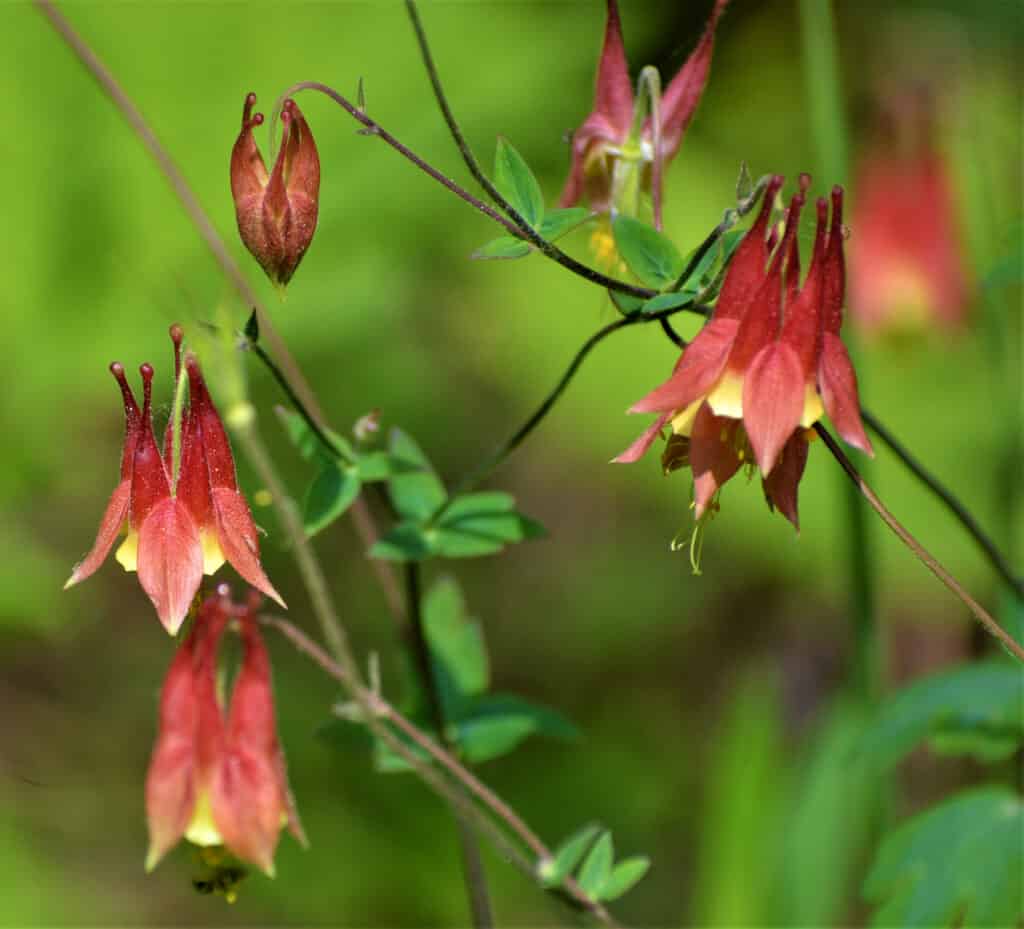
Wild columbine thrives in rich soils and is ideal for naturalizing in woodland gardens.
©akslocum/Shutterstock.com
Despite what this plant’s name might suggest, the Canadian columbine (Aquilegia canadensis) can be found throughout the U.S, including in the state of Kentucky! This native flower stands out in the wild with its delicate, bell-shaped blooms with yellow pets and beautiful bright red sepals. The scarlet sepals grow to be around 1 to 2 inches long.
This plant has a long blooming season from late spring to early summer, generally from May or June. It can be found growing in the sun or part shade in average, moist, but well-drained soils. If you plan to grow the Canadian columbine in your garden, ensure the soil never goes dry if you want it to survive and thrive. All in all, this plant is relatively easy to grow as long as you keep it in the ideal growing conditions.
Wild columbine thrives in rich soils and is ideal for naturalizing in woodland gardens. It’s a beautiful addition to any garden with its fern-like foliage, and the hummingbirds will love it! Don’t worry if you have herbivorous mammals in your vicinity, as rabbits and deer will ignore this plant. So add some wild columbine to your garden this summer and enjoy watching nature at its best.
9. Purple Coneflower (Echinacea purpurea)
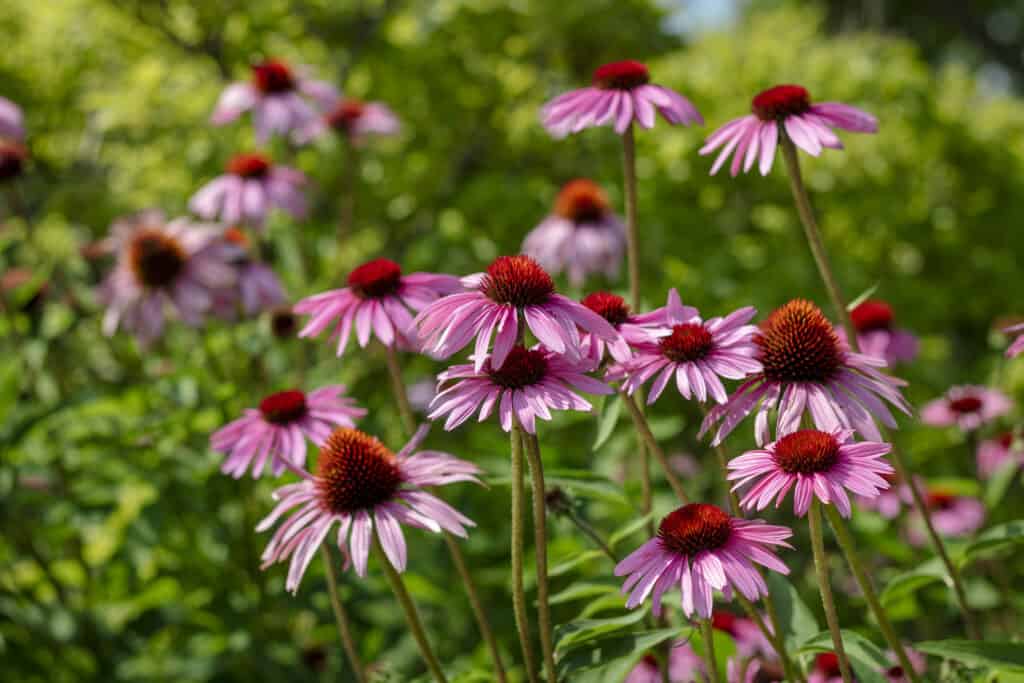
Purple coneflower is an easy-to-find perennial.
©iStock.com/Air Footy
A beautiful plant in the daisy family that is native to Kentucky, purple coneflower (Echinacea purpurea) is an easy-to-find perennial with a height ranging from 2 to 5 feet. It blooms in the summer and fall with vibrant pink or purple petals and a spiny, conical-shaped center dome – hence its name!
The purple coneflower also has a rich history, with Native Americans using the root of this plant to cure illnesses, like issues with digestion or even pain! The petals of the purple coneflower are also said to have anti-inflammatory abilities. In addition to medicine, there is a variety of other great uses for purple coneflower, including dried flower arrangements or herbal teas.
Please note: A-Z Animals does not recommend plants or herbs for medicinal or health use. We present the following information for academic and historical purposes only.
This hardy and tall plant is a popular choice for planting in natural gardens and areas that have been disturbed. It’s also an excellent choice for attracting butterflies as it produces nectar and pollen and has a pleasant smell. With minimal care, you can enjoy these happy flowers in your garden season after season.
Summary of the 9 Native Plants in Kentucky
| Number | Type of Plant |
|---|---|
| 1 | White Snakeroot |
| 2 | Blue-Eyed Grass |
| 3 | Eastern Redbud |
| 4 | American Beech |
| 5 | Bottle Gentian |
| 6 | Black-Eyed Susan |
| 7 | Common Blue Violet |
| 8 | Canadian Columbine |
| 9 | Purple Coneflower |
The photo featured at the top of this post is © Milosz Maslanka/Shutterstock.com
Thank you for reading! Have some feedback for us? Contact the AZ Animals editorial team.






